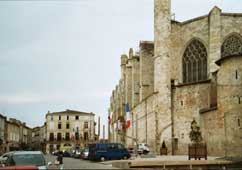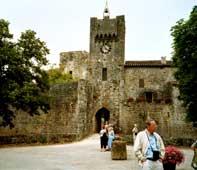 |
Patrick Delaforce & Ken Baldry'Family History Research - volume Two - The European Dimension' - Chapter 34 - The Prelates |
Chapter 34
"Churches built to please the priest" ROBERT BURNS 1759-1796
The Prelates
|
The Feudal church allowed the Lord of the Manor to be a Bishop or an Abbot. Many monasteries and cathedrals shared in parish titles but additional funds were always needed which came mainly from the nobles in gifts of land or money or goods and chattells, including Vignes, wine, cattle and serfs. For instance the Abbey of ALCUIN near Tours owned or was Lord of 20,000 serfs who paid a small head tax, a small rent (CENS), and a tax called TAILLE. Another example in 1128 shown in the ecclesiastical diocese of AGEN (Source comte d'Agen book 2, p909) GAUTERIUS/WILLIAM del FOSSAD dedit FORTONI de VICO (modern VIC-FEZENSAC) infuslam de VICO cum terris cultis et incultis, pratis, pascuis, aquis, aquarurave ductilus et alus allia centis (vents). FORTO verode VICO dedit eamdam sanctimonialilus FONTIS-EBRALDI in manu Aldeberti episcopi Agennensis. Archbishops, bishops and abbots received investiture from the King, pledged their fealty to him, carried titles such as Count or Lord, minted coin, presided over ecclesiastical courts and the feudal tasks of military service. In France armed Bishops and Abbots were not unusual! Three 'holy' orders - subdeacon, deacon and priest - were not allowed to marry, but there was little to discourage Bishops and Abbots from marriage. The following Chronological table illustrates the five centuries when the family were prelates - a Cardinal; many Bishops and Abbots in four main areas. The small towns around Bordeaux; POITOU; central Gascony and the Agen area. The main source for this chapter is the 16 volume series of GALLIA CHRISTIANA and the Inventaires-Sommaires of Bordeaux/Gironde; Gascony and Poitou. In the period 978/980 AD there were three references "PRETRE (which then meant an ecclesiastical title) donne deux ALEUX" (freehold land) to the PRIORY of the BENEDICTINES at La REOLE. Also "FORTIS of MAS or MANSIO (MASS lOTS) was Abbot of La Reole”; finally "FORTIS GARSIUS, was Abbot of BLANDIMONTE (modern BLASIMON, north of La Reole) in 980 AD. In 1034/5 FORTONE was Abbot of the monasteries of PASSAN and SORDE in Gascony: WILLIAM FORTON I and II father and son were Abbots of SIMORRE (SE of AUCH) in the period 1000-1050. 1060-1080 FORTO was the 4th PRIOR of St Pierre of La REOLE. In 1062 FORTO BRASCUS was a Decanus/deacon of St MONT Abbey on the boundary of Gascony and Landes. BRASCUS was related to BRACHEOTTE d'ARMAGNAC who married WILLIAM de FORCE about 1000 AD. In the same period 1060-80 FORTIS/FORTON was the 4th Prior of the BENEDICTINES of BOURDELLES, near La Reole, and FORTIS de ROTLAND was Chanoine of the church of Saint Emilion, with a wife and children. In 1108 5. William FORT/FORTIS GAUCELMI was archpriest 'alios laudavit', St FIDIS, MANSTROT (near La Reole): "Donation l'un SERF et des fils a l'abbaye de Sainte Croix de Bordeaux par GUILLELME FORT d' ORNON". FORT AYQVELIN gave 'terre BETORAR-LUDORN' to the same Abbey in the period 1122-1131. 1120-1144 GARSIE FORT was Bishop of BAZAS. 1125/30 BERNARD FOSSAT was BISHOP of AGEN and his son RAYMOND BERNARD was also Bishop in 1142-9. GUILLELMI FORTIS/FORTO of PELAGRUA was Archdeacon of Agen in the same period. 1136-1154 WILLELMUS FORTZ was CELLARIUS of St Mary's Cathedral in AUCH. 1167 WILLIAM BERNARD FORT and his brother BERNARD de FORT were archpriests of ORNON, CESTARS and UPIAC outside Bordeaux. 1158-1191 PEREGRINE was the notorious Abbot of CONDOM, Gascony. 1190 AIQVEUNOS/GUILHERMINUS FORT was saceedote - priest of MACAO. 1193 RAYMUND FORTONIS, was Abbot of BOLBONAE and VAJAL near Toulouse. In 1204 BERNARD of AIZ was Abbot of St Emilion, the wine growing area east of Bordeaux. But now for the first time records show family prelates in POITOU. Saintes or XAINTOINGE is due north of Bordeaux and SE of OLERON and ROCHEFORT. The family that produced the EARLS of ALBERMARLE (chapters 36-37-38) also produced Bishops in this area. In 1216 WILLELMUS III FORTIS was initially Prior of XANTONIO, then Abbot "Lic venerabilis pater, vir noblis, mirae providentiae" and then three generations of RELIES I, II and III in the period 1200-1267 were Bishops of Saintes. At the end of the century HUGO FORLIN was Cellarer of St Marys, Poitiers. In 1255 ARNOLD was Bishop of Bazas: ODON archdeacon of Agen. In 1268-73 SANCIUS FORCIO was Chanoine of LADOS in the Gironde and ARNALD de FORCES was a Franciscan brother in Auch. In 1283 FORCIUS of EAUZE was Abbot of the Monastery of BASSOUSE. In 1318 FORT, Bishop of POITIERS preached a 'serment de fidelité' to ARNALD, arch-eveque of Bordeaux. This may have been RELIES preaching to his uncle! In the 14th century the family prelates in Condom were William Raymond de FORTELLI, sacristan 1318-45, another PEREGRIN was Bishop in 1340. The Bishops of Condom had built for themselves the lovely fortified village fortress of LARRESSINGLE to the west of Condom.
Bordeaux area prelates included Eblonem de FORCIA Prior of Barsac in 1357; ARNALD de FORCIA, Canon of St Jacob in Bordeaux who paid hommage to the Black Prince in 1365. BERNARDUS IV de La Fours 1368-86 was made Bishop of FONTIS-VALLICUM/FRARQUEVAUX = BELLEGARDE and later GRANDIS-SILVAE or SEOUBE, both in Gascony between Auch and Verdun-sur-Garonne. His son BERNARD and grandson BERNARD were Abbots of the Monastery of MEIMACI (Meymac) on the Auvergne borders in the period 1384-1433. BERNARD de la Fours (Gallia Christiana XIII col 138) had a distinguished career. He was Abbot of FONTISVALLIUM (diocese of NIMES) in 1351; then to SINANQUE (possibly SENONCHES (north of LE MANS), then in 1368 to GRANDSELVE in Gascony. In 1370 Louis, Duke of ANJOU, wrote 'des lettres (to Bernard) portant main-levée du temporel du monastere qui avait été saisi par les reformateurs generaux du Languedoc (i.e. the CATHARS and ALBIGENSIANS). In 1376 Bernard made “a reservoir sur la Garonne (Grandselve is on the banks of this river) pour y prendre du poisson a l'usage des religieux moyennant une redevance annuelle de 6 deniers toulousains payable dans les mains du Bailli de Verdun”. He was in the Chartes of 1377 and 1386. In 1391 he accepted 'a domino' the Lordship of FAU-DOANISSA near Montauban. It is possible that Gallia Christiana have included a father and son in this long saga. The PAPACY in AVIGNON At the beginning of the 14th century France was the most powerful Christian nation in Europe. Pope Boniface in Rome was constantly at loggerheads with King Philip IV in Paris. "Bulls" were despatched and officially burned in Paris. Benedict XI, Boniface’s successor, excommunicated many of the French prelates. Philip IV agreed to support BERTRAND de GOT, Archbishop of Bordeaux, for the papacy if he was more 'co-operative'. In 1305 he was chosen Pope and took the name CLEMENT V. The Cardinals warned him that his life would be unsafe in Rome (Benedict had been apparently poisoned by the Italian Ghibellines). The papacy was moved to Avignon on the river Rhone outside the south eastern border of France, where it stayed for 68 years. The Pope was a Gascon and technically a British subject of King Edward III.' On 3rd December 1508 King Edward named members of his "conseilleurs d'Aquitaine trois cleros (magistrates) appartenant à deux familles apparentées à celle de Pape Clement V et tres influents aupres de lui. FORCIUS d'AUX (Auch), Chanoine de Poitiers qui cumule deja maints benefice a moms de vingt ans. Il est proche parent (close relation) d'ARNAUD FORCIUS d'AUX ancien secretaire de PAPE CLEMENT V devenu eveque de Poitiers". Pope Clement stayed for a time in Poitiers about 1507. Delaforces in the Poitou family had been prelates since 1200. So it was natural for Bertrand de Got to include ARNAUD, another Gascon with good connections in Bordeaux, as one of his Cardinals. Both owned vineyards there; Bertrands became famous as Chateau Pape-Clement. The Vatican papers (Reg.65 epistle 2834) in 1319 show 'FORTIUS d'AUX, neveu de Cardinal ARNAUD d'AUX', born LARROUMIEU, GERS, 'promu' (promoted) to be l'eveque in 1318. His stipend was a 'pension of 50 marcs sterling' a year (Gascon Roll 24 membrane 18 Acte 140). ARNOLD became 'CAMERIEUR du PAPE', the Pope's Chamberlain and Cardinal about 1310. A succession of French Popes controlled by a college of French cardinals wielded the same authority as previously emanated from Rome. In 1345 Pope Clement VI observed 'If the King of England were to petition for his ass to be made a Bishop we must not say him nay.' Perhaps Arnold and his nephew RELIES had something to do with that attitude! In 1354-60 ELIAS FORT was 'tabellion du Pape' in Montauban and Cahors. Plague broke out in 1347 in the Carmelite convent of friars in Avignon: it returned in 1361 and eight cardinals died of it. In 1368 BERNARD IV de la FOURS, promoted by Pope URBAIN V (another Avignon Pope) to become Abbot of the Cistercian Abbey of GRANDE-SELVE. The 'Babylonian captivity' lasted to 1377 when GREGORY returned to Rome. The Avignon Popes had named 113 Frenchmen to the college of cardinals in a total of 134 nominations, but Avignon had become a venal, licentious place and France was in chaos: its King a prisoner in England, its armies shattered and the English reconquering the southern provinces and advancing nearer to Avignon. There were a lot of valid reasons for the departure of the Papacy back to Rome, but in 1378 a disputed Papal election caused the dual Papacy and the Great Schism which lasted for another half century with two, and occasionally three, Popes at a time. Each Pope demanded the payment of ecclesiastical taxes and each excommunicated the other as anti-Christ. |
|
Contact: Ken Baldry for more information, 17 Gerrard Road, Islington, London N1 8AY +44(0)20 7359 6294 but best to e-mail him |

